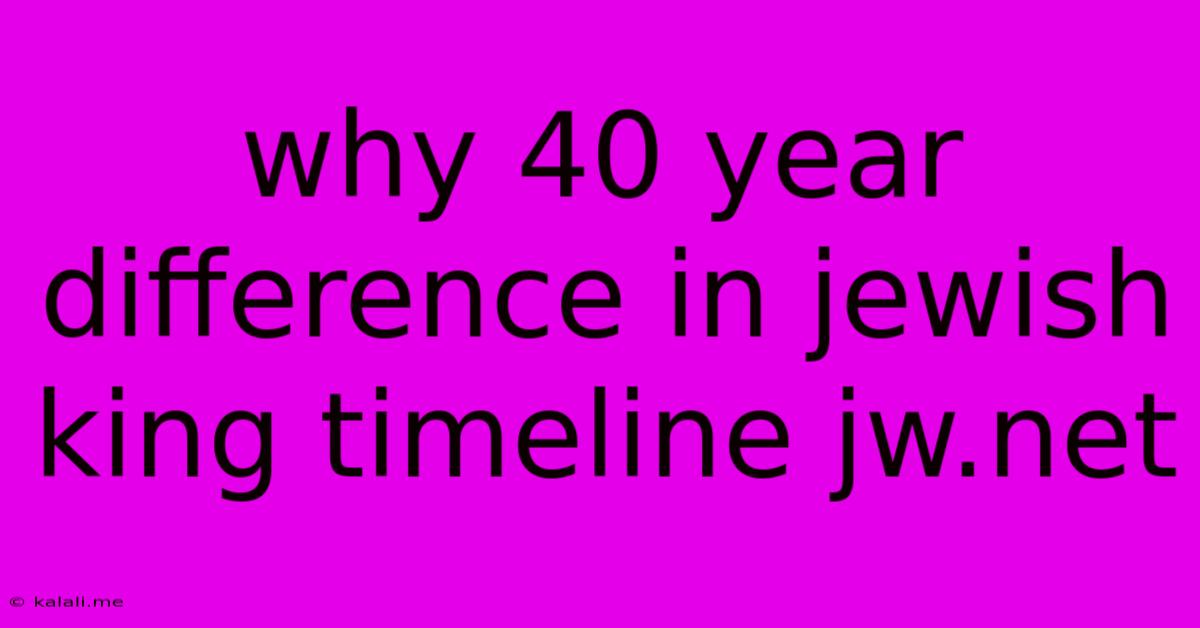Why 40 Year Difference In Jewish King Timeline Jw.net
Kalali
May 24, 2025 · 3 min read

Table of Contents
The 40-Year Discrepancy in the Jewish King Timeline: Resolving the Apparent Contradiction
The Jewish calendar and historical timelines often present intriguing discrepancies, and one such puzzle centers around a seeming 40-year gap in the reigns of the Kings of Judah and Israel. This perceived inconsistency between different biblical accounts has led to much discussion and attempts at reconciliation. This article explores the potential reasons behind this apparent discrepancy, examining the complexities of biblical chronology and highlighting the various interpretations offered. Understanding this helps us appreciate the challenges of working with ancient texts and the multifaceted nature of historical reconstruction.
The Problem: A 40-Year Gap?
The apparent discrepancy lies in comparing the regnal years of the kings listed in the books of Kings and Chronicles with other chronological frameworks. Some scholars point to a roughly 40-year difference between the implied timeline based on the individual reigns and other historical data. This isn't a simple matter of adding up numbers; the challenge stems from several interconnected factors:
- Different Sources, Different Perspectives: The books of Kings and Chronicles, while covering overlapping periods, present the information from slightly different viewpoints and with different emphases. This variation can lead to discrepancies in the details of reigns and succession.
- Syncretic Influences: The kingdoms of Israel and Judah existed within a complex political landscape, interacting with neighboring empires and experiencing periods of both independence and subjugation. These external influences could impact the internal timelines and records.
- Ambiguity in Biblical Text: The biblical text itself isn't always explicit about the exact start and end dates of various reigns. Issues like coregencies (two rulers ruling simultaneously) and uncertainties about the length of certain reigns contribute to the challenge.
- Scribal Errors and Transmission: Over centuries of transmission, scribal errors or unintentional alterations to the text could have crept in, leading to small inaccuracies that accumulate over time.
Potential Explanations and Interpretations:
Several explanations have been proposed to account for the apparent 40-year difference:
- Parallel Reigns and Coregencies: It's possible that the discrepancy arises from the simultaneous reigns of different kings in different parts of the kingdom, or within the same kingdom. If not clearly stated, this would lead to misinterpretations.
- Interregnums and Periods of Instability: Periods of civil war, rebellion, or other political upheavals could be responsible for the difference. These periods of instability might not be explicitly accounted for in the regnal lists.
- Alternative Chronological Frameworks: Some scholars propose alternative chronological frameworks that seek to resolve the apparent discrepancy by adjusting the dates of various events based on extra-biblical evidence such as archaeological findings. These are often debated.
- Interpretational Differences: Different scholars interpret the biblical text in varying ways, leading to different reconstructions of the timeline. What one scholar views as a coregency, another might see as consecutive reigns.
Beyond the Numbers: The Bigger Picture
While resolving the exact nature of this 40-year discrepancy remains a subject of ongoing scholarly debate, focusing solely on the numerical discrepancy risks overlooking the larger narrative. The books of Kings and Chronicles, despite their chronological complexities, offer valuable insights into the history, religious life, and societal structures of ancient Israel and Judah. Their enduring influence on Jewish history and theology makes understanding their contents, including their chronological challenges, crucial for appreciating their contribution to our understanding of the past.
Conclusion:
The apparent 40-year gap in the Jewish king timeline presents a fascinating challenge for biblical scholars. It underscores the complexities of working with ancient texts and the need for careful consideration of multiple factors—historical context, textual interpretation, and potential sources of error. While pinpointing a definitive solution remains elusive, exploring the various explanations enhances our understanding of the methods used in biblical chronology and the richness of the historical narrative itself. The key is not to dismiss the discrepancy as an error, but rather to embrace it as a window into the challenges and subtleties of reconstructing ancient history.
Latest Posts
Latest Posts
-
The Square Of Sum As Integral
May 24, 2025
-
Wiring Diagram For Double Switch For Fan And Light
May 24, 2025
-
How To Get The Smell Of Gas Off My Hands
May 24, 2025
-
Car Whose Name Anagrams To My Car
May 24, 2025
-
Bullx Wallet Is Changed And Empty
May 24, 2025
Related Post
Thank you for visiting our website which covers about Why 40 Year Difference In Jewish King Timeline Jw.net . We hope the information provided has been useful to you. Feel free to contact us if you have any questions or need further assistance. See you next time and don't miss to bookmark.